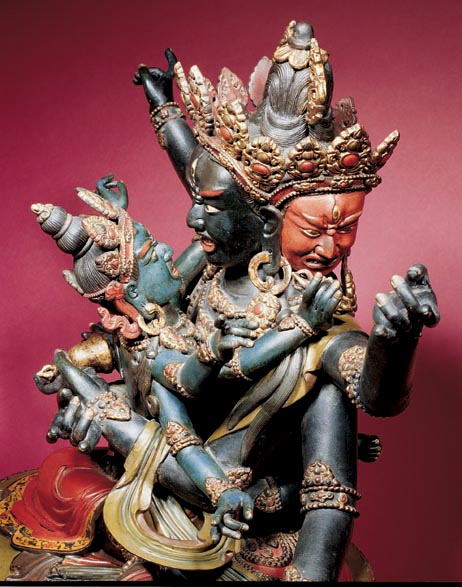

|
China c. 17th century Polychrome lacquer Height - 58.4 cm |

Detail: close up The name translates as �secret assembly� and the full name of the tantra reveals that it is concerned with the secrets of the body, speech and mind of all the tathagatas (the five jinas or five great Buddhas of wisdom). The Guhyasamaja tantra and the Chakrasamvara tantra work in tandem as an integrated methodology to reveal the essential yogas for achieving enlightenment, representing method and wisdom respectively. The Guhyasamaja, Chakrasamvara and Vajrabhairava tantras fulfil the roles of the threefold classification of father, mother and non-dual tantra. Guhyasamaja is a mild form of yi-dam (tutelary deity), and the tantric form of Vajradhara. He is dressed like a crowned Buddha, with the rank of a Buddha. He is generally represented seated and has three heads, each wearing a five-leafed crown. He has six arms: the primary hands are crossed behind the sakti�s back and hold the vajra and the ghanta; the others generally hold the wheel, the sword, the padma and the blazing magic jewel. The sakti called Sparshavajra also has six arms and holds the same symbols as the yab. The implements symbolise the various Buddha clans of the five jinas: the vajra and ghanta symbolise the Vajra clan of Aksobya; the wheel represents the Wisdom clan of Vairochana; the lotus is the Discriminating Wisdom clan of Amitabha; the jewel is the Equality Wisdom clan of Ratnasambhava; and the sword is the All-Accomplishing clan of Amogasiddhi. Together with each of the dhyani Buddhas� being represented, Guhyasamaja also symbolises the union of all the Buddha clans. |
|
|